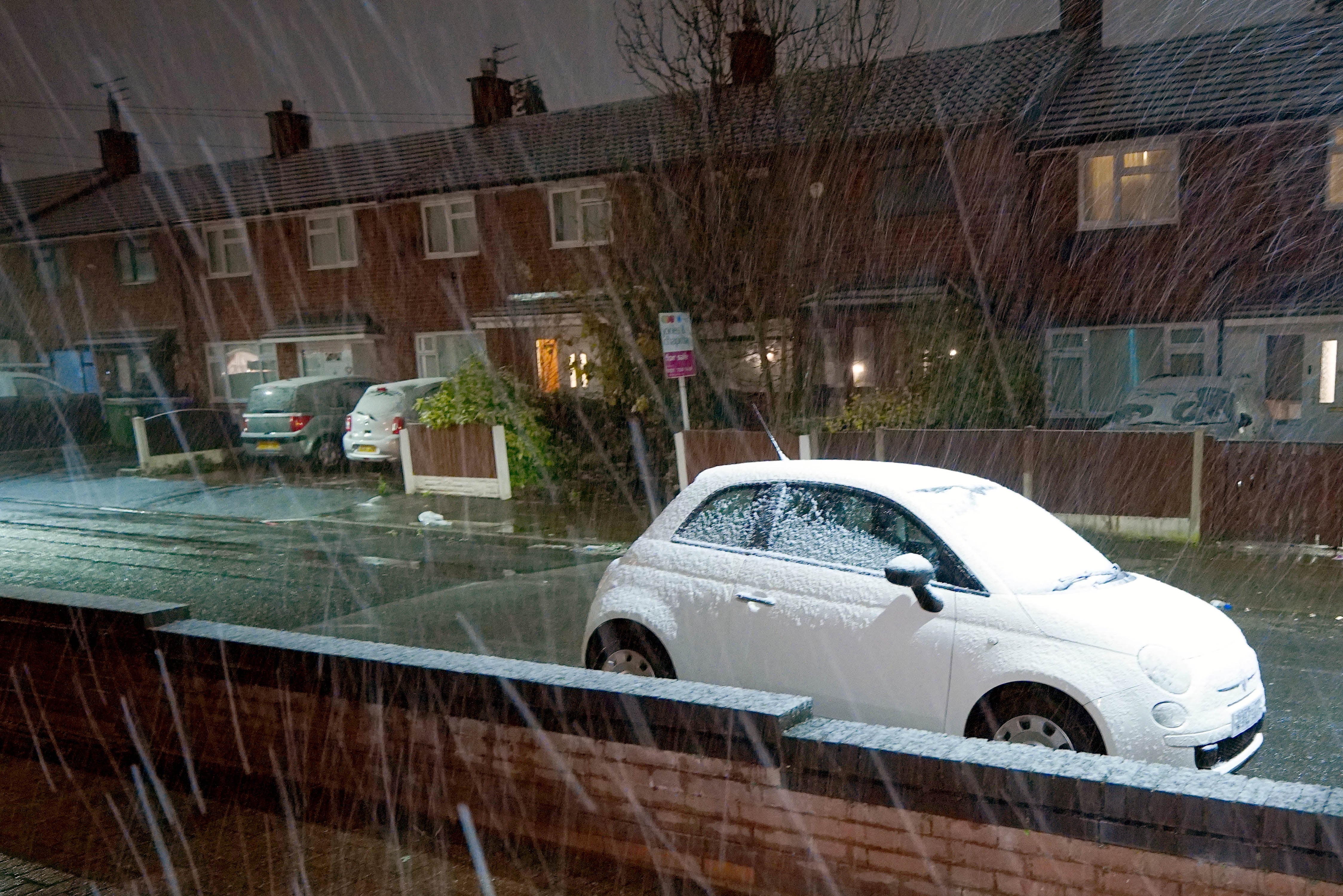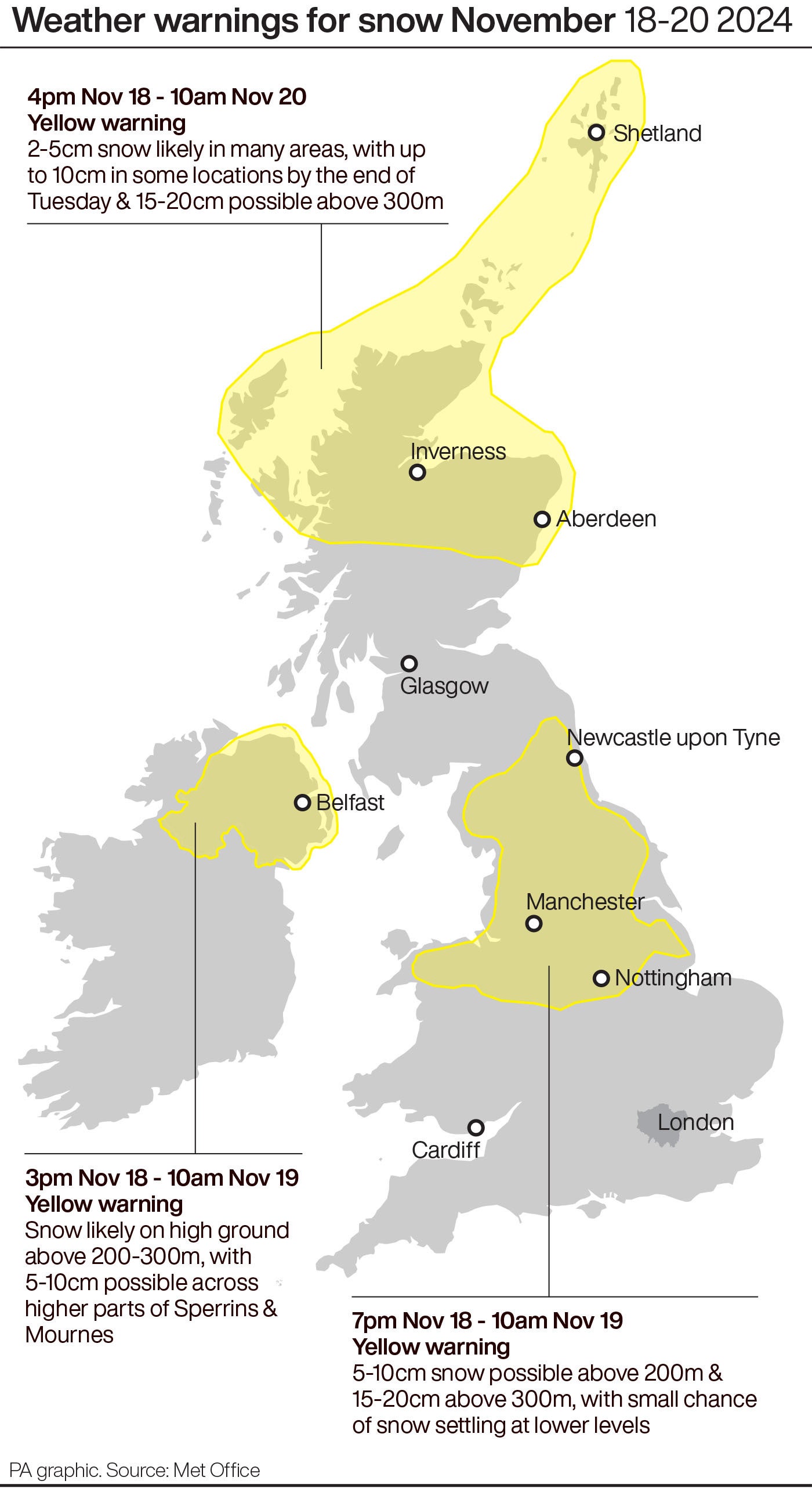
Drivers in parts of England have been warned and train services cancelled after severe weather warnings were issued across the UK.
Many woke up on Tuesday to a blanket of snow.
The Met Office issued three yellow weather alerts for snow and ice covering the Midlands, northern England, parts of Northern Ireland, north east Wales and sections of Northern Ireland.
National Rail warned the cold climate would impact various routes on the Northern Rail until at least 2pm on Tuesday.
Monday brought a very cold start for many, especially in northern Scotland. Here are the extremes 👇 pic.twitter.com/5HdCGNWiaK
— Met Office (@metoffice) November 19, 2024
Impacted areas included the Bradford Interchange and Huddersfield, and also between Halifax and Hebden Bridge and Hull.
Mersey Rail issued an alert warning passengers that due to the potential of snow and ice covering tracks, the first service on each line in north west England would run without customers to ensure conditions could be checked.
Travellers were advised to check their local rail app or social media and plan their journeys ahead.
National Highways have issued an amber severe weather alert for snow in the North East and North West regions of the country from today (Tuesday 19th November) until 10:00.
— National Highways: North-West (@HighwaysNWEST) November 19, 2024
Visit our Travel Alerts page for full details - https://t.co/aVxQ0AwS7I…@metoffice pic.twitter.com/3LtnEvQWze
Dan Suri, Chief Meteorologist at the Met Office, said: “An area of low pressure slides its way eastwards on Monday night. The associated frontal system, marking the boundary between cold air in the north and milder conditions to the south, will bring disruptive snow to some areas between Monday evening and Tuesday morning.
“This is likely to coincide with rush hour, leading to disruption to some transport routes across a central swathe of the UK on Tuesday morning. It will also be windy in the far south.”
⚠️ Yellow weather warning UPDATED⚠️
— Met Office (@metoffice) November 18, 2024
Snow and ice across parts of northern England, Wales and the Midlands
Valid until Tuesday 1100
Latest info 👉 https://t.co/QwDLMfS950
Stay #WeatherAware⚠️ pic.twitter.com/UhZCuAsR7N
Motorists were also put on high alert, with the National Highways issuing an amber severe snow alert for roads across the North East and North West of the country. Road users were advised to take extra care and avoid the area if possible.
Impacted roads included the M26 between J21-J23, the M1 at Leeds and Sheffield and the M56 at Manchester.

It comes as the UK Health Security Agency (UKHSA) issued the first amber cold weather health alert of the season this week.
The amber warning covers the east and north of England, midlands, and Yorkshire and the Humber, with yellow alerts coming into place for the South East, South West and London at 8am on Tuesday, lasting until 6pm on Saturday.
A yellow snow and ice warning is currently in place until 10am on Tuesday covering Northern Ireland.

Another yellow alert is in place until 10am on Wednesday, covering areas in Scotland, and a third lasts until 11am on Tuesday covering areas in the East Midlands, Yorkshire and the north of England.
Within affected areas, there is a chance of power cuts, disruption to road and public transport and the risk of injury from slipping on ice.
Tips for driving in snow
Ice Scraper
A cheap and easy way to make sure you’re not late for work is an ice scraper. It will quickly and effectively clear the sheet ice on your vehicle’s windows without damaging the glass and will allow you to get on the road in a short space of time.
They are compact, cheap to buy and can be stored anywhere in your car – or if you buy a Skoda, you get one built into the fuel filler door.
De-icer
De-icer, as the name suggests, is another quick and easy way of removing ice and snow from the windows of your car.
Unlike an ice scraper, a de-icer spray is used to burn through the frost and will prevent it from icing up again for some time thanks to the use of the chemical ethylene glycol. As water has a freezing point at zero degrees, de-icer can dissolve a frozen windscreen from as low as -12-degrees – making it a quick and easy solution to those cold and crisp mornings.
Winter tyres
Not everybody wants to spend a few hundred pounds on some new rubber for their car. But, if you live in an area that doesn’t have a lot of gritted roads or steep inclines which can get icy and dangerous, then winter-specific tyres can have a big impact.
They come fitted with chunkier tread patterns and are ideal for cars with four-wheel-drive and will save you the bother of getting stuck or losing grip at the most unpredictable time. Plus, winter tyres get a specific compound which allows them to grip the road more effectively at lower temperatures when compared with a typical summer tyre.
Phone chargers
Always carry phone chargers with you because in the event of a breakdown, accident or if you get stuck having your mobile fully topped up will save you a whole load of hassle.
It can also be very dangerous to drive around in the winter with limited battery life on your phone because in an emergency situation your mobile phone is your best friend. Most modern cars also come with wireless charging pads, however, they are not as reliable or fast to charge as a traditional USB or USB-C wire.
Check fluid levels on your vehicle
One of the most sensible and simplest things to do is to have a basic maintenance check or even a service before driving this winter. Check the vital fluids under your bonnet such as coolant, brake fluid, engine oil and washer fluid.
If you don’t, you could land yourself at a higher risk of breaking down or damaging your engine. If you’re unsure, another good solution is to take your car to a garage and get it fully serviced before using it this winter. That means that it will give your car a clean bill of health, while also benefiting from fresh engine oil, brake fluid, coolant and even a top up of screen wash.
Take a hat and scarf
It may be wise to invest in some simple winter gear just to take with you on your travels. When driving in the winter, your car will take longer to warm up and therefore will take longer for the heater to start blowing in warm air.
Keeping a hat and scarf in your car are quick and effective ways of staying warm when driving. Staying warm will make it easier for you to concentrate as being cold behind the will could cause you to lose focus and bring a greater risk of an accident. If an accident were to occur during colder weather, then a small number of warm clothes could help to keep the cold at bay when stuck at the roadside, too.







